Abstract
As smart campus construction continues to advance, traditional safety monitoring and environmental sensing systems are increasingly showing limitations in sensitivity, anti-interference capability, and deployment flexibility. Optical fiber sensing (OFS) technology, with its advantages of high sensitivity, passive operation, immunity to electromagnetic interference, and long-distance distributed sensing, provides a novel solution for real-time monitoring and early warning of critical campus infrastructure. This review systematically examines representative applications of OFS technology in smart campus scenarios, including structural health monitoring of academic buildings, laboratory environmental sensing, and intelligent campus security. By analyzing the technical characteristics of various types of optical fiber sensors, the paper explores emerging developments and future potential of OFS in supporting intelligent campus construction. Finally, the feasibility of building data acquisition, transmission, and visualization platforms based on OFS systems is discussed, highlighting their promising roles in campus safety operations, the integration of teaching and research, and intelligent equipment management.
1. Introduction
With the rapid advancement of emerging technologies such as mobile internet, cloud computing, big data, and artificial intelligence, the digital transformation of education is accelerating toward an era of intelligent development [1,2]. Smart campus construction, which emphasizes personalized learning support and intelligent management systems, is driving a paradigm shift in education from large-scale, uniform instruction to precise, data-driven teaching models. As the foundational infrastructure of modern education systems, campuses are undergoing comprehensive upgrades in informatization and intelligence, which have become key priorities in global education reform agendas. Countries and regions such as the United States, the European Union, and Singapore have successively released strategic documents, including the National Education Technology Plan (2017), the Digital Education Action Plan, and the Future School initiative. These policies emphasize the construction of high-speed networks, intelligent terminals, and digital resources to enhance the efficiency and equity of educational services. In China, since the inclusion of “smart campus” in the 12th Five-Year Plan, a series of top-level strategic documents—such as the Ten-Year Development Plan for Educational Informatization and the 14th Five-Year Plan for National Informatization—have been issued to systematically promote the transition from digital to intelligent campuses. By 2022, the informatization maturity index of Chinese higher education institutions exceeded 75%, with exemplary cases such as Tsinghua University’s “dual-teacher classroom” and Zhejiang University’s “full-link smart education system” showcasing the effectiveness of intelligent campus initiatives.
The development of smart campuses has gone through three major stages: campus networking, digital campus systems, and integrated intelligent ecosystems. Early projects such as MIT’s E-campus primarily focused on network infrastructure and information system integration. Since Zhejiang University proposed the concept of the “smart campus” in 2008, its connotation has expanded to cover the full-cycle intelligent coordination of teaching, administration, and services. With the convergence of cutting-edge technologies such as 5G, the Internet of Things (IoT), artificial intelligence (AI), digital twins, and the metaverse, smart campuses are evolving into cyber-physical systems characterized by immersive integration, data-driven management, and intelligent decision-making [3]. Representative initiatives—such as Stanford University’s data-driven campus governance, Cambridge University’s student-centric intelligent service systems, and the Norwegian University of Science and Technology’s Smart Campus 2060 vision—highlight the trend toward broad environmental sensing, multi-source data fusion, and cross-domain collaboration. Under the combined influence of technological innovation and policy support, smart campuses are progressing toward a future model defined by ubiquitous sensing, fine-grained governance, and adaptive evolution [4].
Against this backdrop, the real-time sensing of campus infrastructure and the proactive assurance of safety have become critical pillars in the architecture of intelligent campus systems [5,6]. Modern campus environments are characterized by extensive spatial distribution, diverse application scenarios, and complex data types. Traditional security systems—primarily based on video surveillance and radio frequency sensors—often face limitations in deployment flexibility, environmental adaptability, and data reliability. For example, video surveillance is often ineffective in conditions of strong light, low illumination, or hidden areas, while RF-based sensors are susceptible to electromagnetic interference and struggle to provide high-precision, long-range monitoring. Moreover, important facilities such as teaching buildings, libraries, and laboratories often lack real-time structural health monitoring systems, making early risk detection difficult [7].
Optical fiber sensing (OFS) technology, based on the principles of optical interference, scattering, and reflection, offers significant advantages, including passive operation, strong electromagnetic immunity, environmental adaptability, and the capability for long-distance distributed deployment [8,9,10]. Unlike conventional electronic sensors, OFS enables high-sensitivity, multi-parameter measurements such as strain, temperature, vibration, displacement, and acoustic signals. Recent advances have extended OFS beyond traditional fiber Bragg gratings (FBGs) to include distributed acoustic sensing (DAS), distributed temperature sensing (DTS), interferometric sensors, and hybrid multiplexed systems [11,12,13]. These techniques have already been explored in smart campus-related scenarios, including underground tunnel intrusion detection, real-time monitoring of laboratory environments, early-warning systems for campus pipelines, and vibration monitoring in sports facilities. The high bandwidth and rapid response of OFS also allow seamless integration with 5G communication, IoT platforms, edge computing, and cloud services, thereby supporting real-time data fusion and intelligent analysis. Moreover, the combination of OFS with AI algorithms has opened up new possibilities for event classification, anomaly detection, and predictive maintenance, further strengthening its role in intelligent campus construction.
Therefore, this review focuses on the application prospects of OFS technologies in smart campus construction. By systematically examining the technical features, deployment strategies, and challenges of various OFS systems, this paper explores their integration with IoT, edge computing, and AI systems. It aims to provide a theoretical and practical foundation for constructing high-reliability, low-energy, wide-coverage safety and environmental sensing systems that support the evolution of smart campuses toward an intelligent “perception–decision–control” closed-loop ecosystem.
2. Why Choose Fiber Optic Sensing Technology
The OFS technology has rapidly become a cornerstone in the evolution of smart campus infrastructure, delivering reliable, high-performance solutions for structural health monitoring, environmental sensing, security, and energy management. Unlike conventional electronic sensors, OFS exhibits outstanding advantages such as strong immunity to electromagnetic interference, support for long-distance signal transmission, high sensitivity, and multi-parameter distributed measurement capability [14,15]. These features enable OFS to operate with exceptional reliability in complex and demanding environments, including underground tunnels, chemical laboratories, and high-voltage equipment rooms. Recent advances in fiber materials—such as polymer fibers and nanocomposites—have further enhanced the mechanical flexibility and application breadth of OFS, facilitating seamless integration into building structures, wearable systems, and other infrastructural elements [16,17]. Furthermore, OFS architectures have evolved from simple point-based solutions to quasi-distributed and fully distributed sensing networks, enabling kilometer-scale coverage with meter-level spatial resolution [18,19]. The inherent multiplexing capability of OFS not only reduces installation complexity but also lowers the overall system cost, making it an ideal candidate for scalable, intelligent campus deployment. As the demand for real-time situational awareness, safety assurance, and sustainability increases in modern educational environments, OFS is poised to become a transformative enabling technology for next-generation campus management. This section discusses the fundamental advantages of OFS technology and its significance for campus-scale applications [20,21].
2.1. Easy Integration and High System Compatibility
OFS systems are inherently modular and can be readily integrated with existing campus infrastructure. Their flexible deployment options—within walls, ceilings, underground conduits, or along perimeter fences—minimize disruption to existing structures and operations [22,23]. This adaptability is particularly valuable in large, heterogeneous environments where multiple subsystems—including security, HVAC, and structural monitoring—require unified sensing networks. OFS signals can be seamlessly interfaced with mainstream IoT gateways and data acquisition platforms, supporting real-time analytics through cloud computing or edge intelligence [24,25]. Through multiplexing, a single fiber can accommodate numerous sensing points, significantly simplifying wiring requirements and reducing installation costs. Additionally, one OFS cable can simultaneously support multi-functional sensing (e.g., temperature, strain, vibration), enabling dynamic adaptation to evolving monitoring demands and maximizing long-term cost-effectiveness [26,27].
2.2. Intrinsic Safety and Suitability for Enclosed or Flammable Environments
A key advantage of OFS technology lies in its passive, non-conductive nature, which makes it inherently safe for use in flammable, explosive, or enclosed environments [28,29]. Unlike traditional sensors, OFS systems transmit information via light rather than electrical currents, thus eliminating the risk of sparking or overheating. This makes them particularly suitable for deployment in sensitive locations such as chemical laboratories, fuel storage rooms, and archival facilities. Moreover, OFS is immune to electromagnetic interference, ensuring reliable performance even in environments dense with electrical equipment [30,31]. Its long-range capability allows for centralized monitoring of otherwise inaccessible or hazardous areas, minimizing personnel exposure and reducing maintenance costs. Collectively, these features establish OFS as a secure and low-risk choice for safety-critical monitoring applications [32,33].
2.3. Long-Distance, High-Precision, and Distributed Sensing Capability
Distributed optical fiber sensors (DOFS) leverage the entire length of the fiber as a continuous sensing element, enabling high-precision monitoring across distances spanning tens of kilometers. By analyzing backscattered signals—utilizing techniques such as OTDR, Brillouin, or Rayleigh scattering—DOFS systems can accurately detect and localize variations in strain, temperature, and vibration [34,35]. This capability is particularly valuable for monitoring extensive campus assets, such as underground pipelines, perimeter fences, and utility networks. Distributed architectures dramatically reduce the need for numerous discrete sensors, simplifying system design while improving fault localization and early warning capabilities. The strong signal-to-noise ratio and multiplexing support of OFS further enable real-time, multi-dimensional monitoring, providing a rich data foundation for predictive maintenance, anomaly detection, and intelligent decision-making in smart campus management [36,37]. Table 1 presents a comparison between optical fiber sensing (OFS) and traditional sensing technologies in terms of cost, accuracy, deployment difficulty, and anti-interference ability.

Table 1.
Comparison between OFS and traditional sensing technologies.
3. OFSs for Monitoring Structural Health in Campus Buildings
Structural health monitoring (SHM) is essential for evaluating the integrity, safety, and long-term performance of civil infrastructure [38,39]. On a smart campus, key buildings such as classrooms, libraries, dormitories, and laboratories are high-occupancy and high-value assets that require continuous condition assessment to prevent failures and extend service life. OFS technology offers a robust and scalable solution for SHM by delivering real-time, high-resolution measurements of strain, temperature, displacement, and other critical parameters [40,41]. Unlike conventional monitoring systems, OFSs can be seamlessly integrated into structural components, providing both localized and distributed measurements. Techniques such as fiber Bragg grating (FBG) sensing and optical time-domain reflectometry (OTDR) enable early detection of stress accumulation, micro-cracks, or deformation trends before visible signs appear. These systems are particularly suitable for complex structures or large campuses, as they combine high sensitivity with long-range coverage and excellent durability. Integration with campus management platforms further enhances operational efficiency by enabling real-time visualization, predictive maintenance, and intelligent alerts [42,43].
3.1. FBG-Based Displacement Sensors for Structural Health Monitoring
FBG is a periodic refractive index structure written into the fiber core using ultraviolet light. It reflects only a specific wavelength of light, known as the Bragg wavelength, while other wavelengths pass through [44,45]. When external factors like temperature or strain change, the grating period and effective refractive index also change, causing the Bragg wavelength to shift. This shift can be measured to detect physical quantities. FBG displacement sensors work by converting displacement into strain, which leads to a Bragg wavelength shift under external force, enabling precise displacement measurement [46]. Therefore, FBGs are widely used in various sensing applications.
In 2018, Guo et al. proposed a high-abrasion-resistant FBG displacement sensor specifically designed for long-term monitoring of steel spring floating slab damping tracks [47]. As shown in Figure 1, the sensing structure is composed of two FBGs fixed to the upper and lower surfaces of a cantilever beam, which receives displacement through a wedge-shaped slider and a precision rolling-bearing system. The mechanical structure also includes a variable-section cantilever, a linear guide rail-slider, a restoring spring, and a pull rod to transfer the external displacement input. The deformation induced in the cantilever beam is converted into measurable strain on the FBGs, allowing for precise displacement monitoring. Performance testing demonstrated a sensitivity of 34.32 pm/mm and a high resolution of 0.0029 mm within a measurable range of 0–90 mm, with good repeatability and low hysteresis. The compact design and robustness of the system make it particularly suitable for alternating micro-displacement monitoring in vibration-prone environments such as railway damping systems or structural foundations in civil infrastructure.
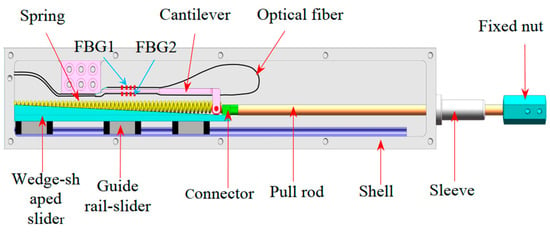
Figure 1.
Structure of the proposed sensor [47].
In 2020, Wang et al. proposed a compact fiber Bragg grating (FBG) displacement sensor based on a tape measure structure, aiming to achieve a small form factor while maintaining a large measurement range [48]. The sensor design incorporates a 1 mm short FBG and a 25 mm cantilever beam, coupled with a specially designed elastic transition structure to enhance strain sensitivity, as shown in Figure 2. This configuration not only ensures high displacement resolution but also expands the linear detection range significantly. Experimental evaluations demonstrate that the sensor achieves a sensitivity of 6.328 pm/mm, a linearity of 0.9997, and a full-scale accuracy of approximately 1.6%. Moreover, the sensor is capable of monitoring displacements over a range exceeding 500 mm. These results indicate that the proposed sensor architecture provides an effective solution for integrating FBG technology into miniaturized displacement sensing systems where both high resolution and large dynamic range are required. This work broadens the application potential of FBG-based sensors in structural health monitoring, particularly in space-constrained or embedded deployment environments. In 2022, Kim et al. developed an FBG displacement sensor capable of measuring vertical displacement by attaching an FBG to the surface of a simply supported beam [49]. The displacement at the end of the beam induces axial stress on the FBG, and experimental results showed a sensitivity of up to 20 pm/mm within a measurement range of 1–10 mm. In 2024, Guangmin Li et al. designed a novel FBG displacement sensor based on a dual-cantilever beam structure [50]. By optimizing the structural parameters of the dual cantilevers, the sensor achieved a sensitivity of approximately 62.68 pm/mm.
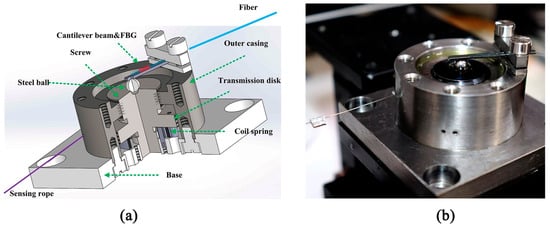
Figure 2.
Displacement sensor (a) 3D structure; (b) picture [48].
3.2. Distributed Optical Fiber Sensors for Structural Health Monitoring
DOFSs offer a powerful solution for large-scale, real-time SHM, particularly suited to the complex and diverse infrastructure of modern smart campuses. Unlike quasi-distributed sensors, which rely on discrete sensing points, DOFSs enable continuous, high-density monitoring along the entire length of the optical fiber [13]. This is achieved through the analysis of back-scattered light signals—specifically Rayleigh, Brillouin, or Raman scattering—that carry spatially resolved information about temperature, strain, and other environmental parameters. The ability of DOFSs to detect physical quantities at any point along the sensing path eliminates monitoring blind spots and significantly reduces the complexity of sensor deployment across campus-scale structures. This advantage is especially valuable in long-span or difficult-to-access areas such as underground utility tunnels, structural beams in multi-story buildings, and aging infrastructure in need of retrofitted monitoring systems. These sensors form a foundational layer for predictive maintenance, early hazard detection, and lifecycle assessment of critical campus infrastructure.
In 1998, M. Froggatt et al. first proposed a novel type of distributed sensor based on the principle of coherent Rayleigh scattering [51]. Their study revealed that the Rayleigh backscattering spectrum distributed along the length of an optical fiber exhibits randomness and uniqueness—an inherent characteristic of the fiber itself. When the fiber experiences changes in strain or temperature, the Rayleigh scattering spectrum undergoes a measurable spectral shift. To quantify this shift, the researchers employed cross-correlation analysis to compare two sets of Rayleigh spectra recorded before and after deformation. The resulting spectral shift can be transformed via Fourier analysis into corresponding strain or temperature data, with the magnitude of the shift being proportional to the applied strain or temperature change. This pioneering work opened new avenues for the development of OFS technology, making it possible to utilize Rayleigh spectral shifts for precise distributed measurements of temperature and strain, as illustrated in Figure 3.
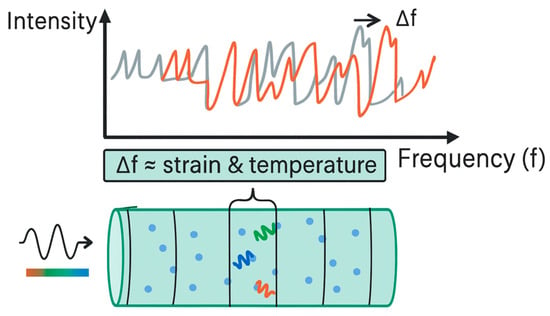
Figure 3.
OFDR strain and temperature measurement principle based on Rayleigh back scattering.
In 2012, Zhou et al. successfully achieved high-precision dynamic distributed strain measurements using OFDR technology through careful system design and implementation [52]. By employing a cross-correlation analysis method, they achieved a spatial resolution of 10 cm over a sensing length of 10 m and attained a strain measurement accuracy as high as 1 macrostrain (1 με). In 2017, Kim et al. introduced a π/2 phase-shift interferometric technique into the detection section and the delay fiber of the reference arm, successfully enabling bidirectional determination of the strain measurement position [53]. This innovative approach not only doubled the original measurement range but also significantly enhanced the measurement performance, providing strong support for further research and applications in the field. In 2020, Cai et al. proposed a distributed fiber optic acoustic sensing (DAS) system for security monitoring in smart campuses, as shown in Figure 4 [20]. By deploying optical fibers along campus roads and facilities, the system captured microseismic signals generated by emergencies, vehicle movement, and congestion events. Through signal denoising, frequency analysis, and short-term energy evaluation, the DAS system was able to detect emergencies with 100% accuracy and achieve precise vehicle localization with errors below 2 m, while also enabling overspeed warnings with an average detection accuracy of 96.85%. This implementation demonstrated the feasibility of DAS in complex campus environments, where traditional video surveillance and RF-based systems are often limited by blind spots, environmental conditions, or electromagnetic interference. such fiber-based acoustic sensing approaches are highly relevant for building intelligent campus infrastructures, enabling real-time incident detection, traffic management, and safety assurance. By extending distributed fiber optic sensing from industrial domains to educational environments, DAS provides a scalable and resilient foundation for smart campus security monitoring.
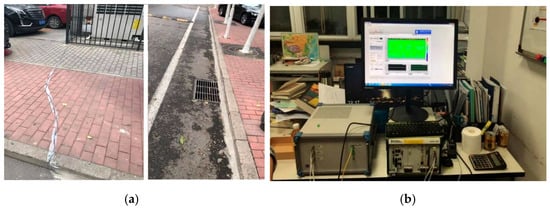
Figure 4.
Security monitoring of a smart campus using distributed fiber optic acoustics. (a) Optical fiber laying position; (b) optical time domain reflectometer.
In 2024, Lin et al. proposed an interfacial-fracture-energy-based analytical model to quantify crack opening displacements (CODs) from distributed fiber optic strain data before and after interfacial debonding [54]. By investigating the interfacial shear stress–slip relationship between the bare fiber and coating through plate splitting tests, they successfully established a method to convert strain data into CODs for both micro- and macro-cracks. This model, validated by experimental and literature data, significantly improved the accuracy of crack quantification, especially under multi-crack scenarios, and offers valuable insights for structural health monitoring involving complex crack behaviors, as shown in Figure 5.
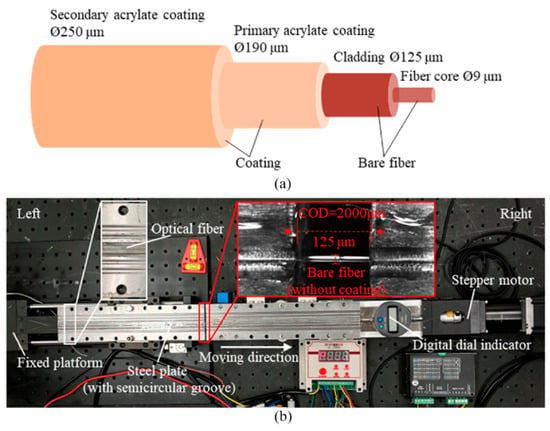
Figure 5.
(a) Structure of an acrylate-coated optical fiber; (b) photograph of the testing platform.
3.3. Structural Health Monitoring of Composite Materials Using Embedded Optical Fibers
With the growing adoption of advanced materials in modern campus architecture, composite materials such as fiber-reinforced polymers (FRPs), carbon fiber laminates, and smart concrete have been increasingly used in high-performance building components—especially in pedestrian bridges, façade systems, laboratory enclosures, and energy-efficient structural modules. To ensure the long-term reliability and safety of these materials, embedded OFS has emerged as a promising approach for internal, real-time SHM. By integrating fiber optic sensors—most notably FBGs—directly into the matrix of composite materials during fabrication, it becomes possible to monitor strain, temperature, deformation, and even crack propagation throughout the lifecycle of the structure. Unlike surface-mounted sensors, embedded optical fibers provide high-resolution, distributed data from within the material body, enabling early detection of internal damage that may not be visible from the outside. This feature is particularly valuable in smart campus settings where safety, durability, and predictive maintenance of complex building systems are increasingly emphasized. Moreover, the compatibility of optical fibers with composite manufacturing processes allows for scalable sensor integration without compromising the mechanical properties of the host structure. These capabilities make embedded optical fiber SHM an essential component in the development of intelligent and sustainable educational infrastructure.
In 2016, Siivola et al. applied a Rayleigh-scattering-based distributed fiber optic strain sensing system to foam core sandwich structures, aiming to detect barely visible yet structurally significant damage caused by indentation and low-velocity impact [55]. By leveraging the high spatial resolution of the sensor, the system successfully captured detailed strain fields during and after impact, enabling accurate estimation of damage location and size. This approach demonstrated robust damage detection performance even under variable environmental conditions and after foam core relaxation, offering a practical solution for real-time structural health monitoring in composite sandwich structures, as shown in Figure 6.
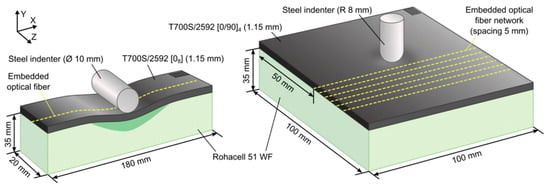
Figure 6.
Illustration of sandwich beam and panel specimens.
In 2020, Califano et al. developed a passive structural health monitoring method based on distributed fiber optic sensors [56]. By embedding the sensors into composite plates and conducting four-point bending tests, they successfully monitored structural damage using an artificial neural network (ANN) algorithm. This approach enabled accurate detection of damage evolution in composite materials under mechanical loading. In 2023, Tan et al. developed a metaheuristic inverse analysis framework to investigate the interfacial mechanics of distributed fiber optic sensors undergoing debonding [57]. By integrating mechanical analysis with metaheuristic optimization and validating through OFDR-based strain measurements, the proposed method accurately quantified interfacial properties, strain transfer, and debonding behavior. The results demonstrated that the model effectively captured the strain distribution across the sensor–substrate interface, advancing the understanding of inelastic interfacial behavior and enhancing the reliability of distributed sensing in structural health monitoring applications, as shown in Figure 7.

Figure 7.
Structure of single-mode optical fibers with dual-layer polymeric coating: (a) components of a single-mode optical fiber; and (b) typical layers of an optical fiber.
In summary, OFS technologies—including FBG-based sensors, distributed optical fiber sensing (DOFS), interferometric fiber optic sensors, and embedded fiber systems in composite materials—offer a powerful, scalable, and high-resolution approach for structural health monitoring (SHM) in modern campus environments. FBG sensors are well-suited for localized, high-precision measurements, while DOFS enables long-range distributed monitoring over tens of kilometers. Interferometric sensors, such as Mach–Zehnder and Michelson configurations, provide ultra-high sensitivity for vibration and acoustic detection, making them particularly effective in scenarios requiring rapid event recognition or environmental disturbance monitoring. By leveraging their respective advantages, these sensing strategies not only enable early detection of strain, displacement, crack propagation, and environmental fluctuations but also provide continuous, long-term data streams for intelligent building management. The integration of these technologies into campus facilities—such as teaching buildings, libraries, laboratories, and underground infrastructure—greatly enhances structural safety, operational efficiency, and lifecycle performance. As smart campuses continue to evolve toward more data-driven, resilient, and sustainable infrastructures, optical fiber-based SHM systems will play a foundational role in enabling real-time diagnostics, predictive maintenance, and adaptive structural responses across educational institutions.
4. Fiber Optic Gas Sensing Technologies for Laboratory Environments
In smart campus environments, laboratory spaces such as chemical labs, materials testing rooms, and energy research facilities are frequently exposed to hazardous gases, including volatile organic compounds (VOCs), toxic industrial gases, and combustible substances. Real-time monitoring and accurate detection of gas concentration in these areas are critical to ensuring personnel safety, environmental compliance, and the integrity of experimental processes. Traditional gas sensing technologies—such as electrochemical, metal oxide semiconductor, and infrared absorption sensors—often suffer from limitations including poor selectivity, susceptibility to electromagnetic interference, and reduced stability under high-humidity or chemically corrosive conditions. Fiber optic sensing technology, with its intrinsic advantages such as high sensitivity, immunity to electromagnetic interference, corrosion resistance, and suitability for harsh or enclosed environments, has emerged as a compelling alternative for gas detection. In particular, FBGs, tunable diode laser absorption spectroscopy (TDLAS), and surface plasmon resonance (SPR)-based optical fibers have been successfully applied for the detection of gases such as CO2, CH4, NH3, and formaldehyde in enclosed laboratory settings. These systems enable remote, non-invasive, and distributed detection, and can be integrated into ventilation ducts, gas pipelines, or wearable devices to provide early warnings of gas leaks or abnormal accumulations. As the construction of smart campuses accelerates, integrating fiber optic-based gas sensing systems into laboratory safety protocols not only strengthens environmental monitoring capacity but also aligns with broader goals of sustainable, safe, and intelligent infrastructure management.
4.1. Optical Fiber Gas Sensors Based on Refractive Index Change
In 2014, Yao et al. proposed an all-optical NH3 gas sensor based on a graphene/microfiber hybrid waveguide (GMHW), integrating it with a Mach–Zehnder interferometer structure [58]. This innovative design exploited the NH3-induced refractive index change in the GMHW, enabling highly sensitive modulation of the transmitted light. The sensor achieved a remarkable sensitivity of approximately 6 pm/ppm and a detection resolution of ~0.3 ppm. Its compact structure, low cost, and ease of fabrication demonstrated strong potential for advancing the development of high-performance optical gas sensors, as shown in Figure 8. In 2015, Quan et al. proposed an open-cavity Fabry–Perot interferometer (FPI) gas refractive index sensor based on photonic crystal fiber (PCF) enhanced by the Vernier effect [59]. This configuration utilized air holes in the PCF cladding to facilitate gas exchange and employed a reflective beam from the PCF end face to generate Vernier modulation. Experimental results demonstrated an exceptionally high refractive index sensitivity of 30,899 nm/RIU. This innovative design significantly improved sensor sensitivity and presented strong potential for gas concentration and humidity monitoring applications, as shown in Figure 9. In 2019, Chu et al. developed a Michelson interferometer-based humidity sensor by side-polishing a dual-core optical fiber and coating its surface with graphene oxide [60]. The sensor demonstrated a wavelength sensitivity of up to 2.72 nm/%RH within the 40–75% relative humidity (RH) range, and an intensity sensitivity of 3.76 dB/%RH in the narrower range of 60–62.1% RH. In 2024, Gaoliang Chen proposed a simple and low-cost optical fiber gas sensor for environmental monitoring applications [61]. The sensor structure is based on a single-mode–multimode–single-mode (SMS) fiber configuration, where the multimode fiber (MMF) segment acts as the gas-sensitive region. The sensing mechanism relies on refractive index modulation induced by gas interaction with the MMF surface, which in turn alters the modal interference pattern. This spectral response shift is used to quantify gas concentration. The sensor exhibited high sensitivity and rapid response, demonstrating reliable detection of ammonia (NH3) and ethanol vapors under ambient conditions. With its ease of fabrication, low cost, and good selectivity, this design offers strong potential for widespread deployment in environmental and industrial gas monitoring scenarios.
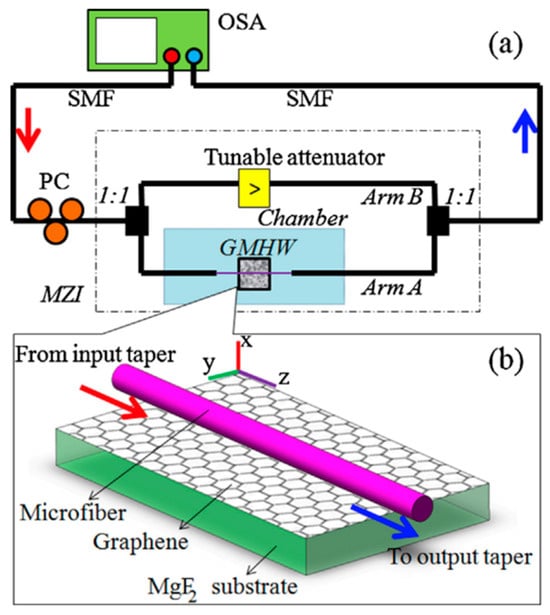
Figure 8.
(a) Setup of the GMHW-MZI for NH3 sensing; (b) schematic diagram of the GMHW.
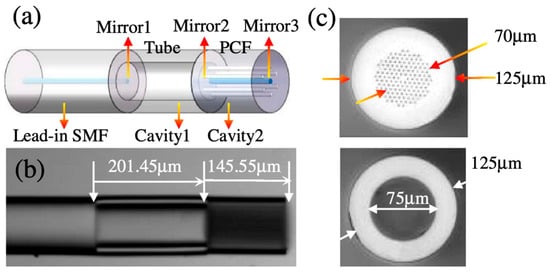
Figure 9.
(a) Schematic of proposed sensor structure. (b) Microscope images of the cross-section of the fiber tube and the PCF. (c) Microscope image of the fiber-tip sensor.
4.2. Photoacoustic Optical Fiber Gas Sensors
In the field of photoacoustic spectroscopy (PAS) gas sensing, the introduction of laser sources in the late 1960s marked the beginning of rapid development in PAS-based gas detection technology. In 2009, Y. Peng et al. developed a novel wavelength modulation photoacoustic spectrometer based on a near-infrared tunable erbium-doped fiber laser and an erbium-doped fiber amplifier [62]. The sensor integrated a longitudinal resonant photoacoustic cell with dual absorption paths and employed lock-in harmonic detection for ammonia sensing. Under ambient temperature and atmospheric pressure, a minimum detection limit of 3 ppbv was achieved with a 100 ms time constant and 500 mW optical power, and the response time was approximately one minute. In 2018, K. Chen et al. developed a near-infrared fiber amplifier-enhanced resonant photoacoustic spectroscopy sensor for sub-ppbv level acetylene detection [63]. The photoacoustic excitation source consisted of a distributed feedback (DFB) laser and an erbium-doped fiber amplifier (EDFA). By measuring the sensor’s linear response to both laser power and acetylene concentration, they confirmed that no saturation of the photoacoustic signal occurred when the excitation power was below 1 W. Under an excitation power of 1 W and an averaging time of 60 s, a minimum detection limit of 0.37 ppbv was achieved, as shown in Figure 10. In 2024, Zhao et al. developed an ultrahigh-sensitive trace gas sensing system using dual fiber optic cantilever-based differential photoacoustic detection [64]. By integrating multipass absorption enhancement with dual-channel Fabry–Perot interferometric detection, this system achieved both high signal amplification and effective common-mode noise suppression. The setup allowed for phase-opposed detection of the photoacoustic signal, significantly improving the signal-to-noise ratio. Under optimized conditions, the system reached a minimum detection limit of 5.1 ppb for H2S in an SF6 background, with a normalized noise-equivalent absorption coefficient of 9 × 10−10 cm−1 W−1 Hz−1/2, demonstrating remarkable sensitivity and practical value for real-time trace gas monitoring. Figure 11 illustrates three representative system configurations employed to enhance optical power in photoacoustic spectroscopy (PAS) applications. Figure 11a shows a resonator-enhanced PAS system, where a phase-modulated laser beam from an external cavity diode laser (ECDL) is locked to a resonator using the Pound–Drever–Hall (PDH) technique. The beam is further modulated and directed into a PAS cell containing the target gas, where the photoacoustic signal is detected and processed using a lock-in amplifier (LIA) [65]. Figure 11b presents a power-enhanced PAS system utilizing a continuous-wave distributed feedback (CW-DFB) laser and an erbium-doped fiber amplifier (EDFA) to boost optical intensity. The enhanced laser beam excites a resonant PAS cell, and the resulting acoustic signals are captured and analyzed using a lock-in amplifier and data acquisition (ADC) system [66]. Figure 11c depicts a laser cavity-based PAS system, in which the PAS cell is integrated directly into the laser cavity. A portion of the light is coupled and recirculated through a fiber optic loop, enhancing the interaction length with the gas. The acoustic signal is generated and extracted using a fiber optic microphone and analyzed using a lock-in amplifier. These configurations represent state-of-the-art strategies for improving PAS sensitivity by increasing the incident optical power or interaction path [67].
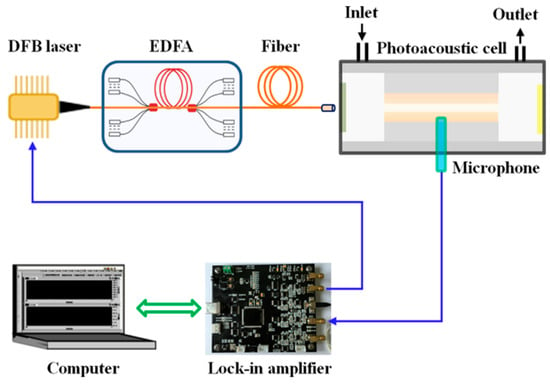
Figure 10.
Schematic structure of the fiber-amplifier-enhanced resonant photoacoustic sensor.
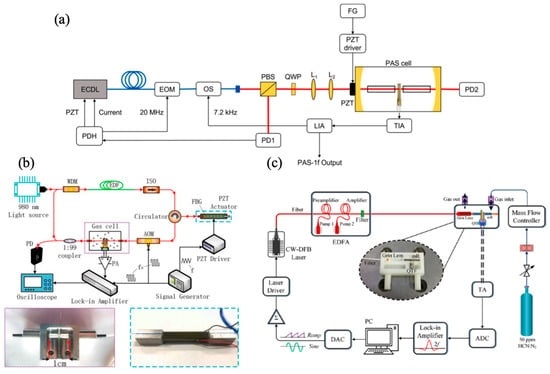
Figure 11.
System diagram of three typical methods to enhance optical power [65,66,67]: (a) Resonator-enhanced photoacoustic spectroscopy; (b) laser cavity photoacoustic spectroscopy; (c) power-enhanced photoacoustic spectroscopy.
4.3. Fiber Bragg Grating-Based Gas Sensing Technology
FBG-based gas sensors operate by detecting changes in the reflected wavelength or intensity of light caused by interactions between target gases and the sensor structure. Typically, a gas-sensitive coating is applied to the fiber surface. When the target gas interacts with this coating—through absorption or chemical reaction—it alters the local refractive index or induces strain, leading to measurable shifts in the Bragg wavelength or changes in reflection intensity. These sensors offer advantages such as compact structure, immunity to electromagnetic interference, capability for remote and distributed sensing, and ease of integration, making them particularly suitable for hazardous environments and real-time gas monitoring applications. Common types include FBGs, which are effective for precise wavelength shift detection, and Long-Period Gratings (LPGs), which are highly sensitive to changes in surrounding refractive index. With the advancement of functional coating materials and fabrication techniques, FBG-based gas sensors hold great promise in areas such as environmental monitoring, safety detection, and industrial process control. Figure 12 illustrates the working principle of an fFBG-based gas sensor.
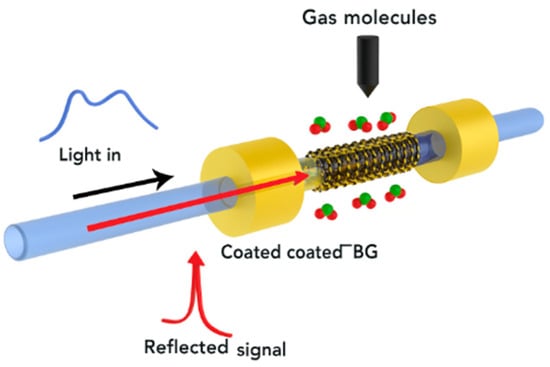
Figure 12.
Schematic diagram of a fiber Bragg grating-based gas sensor.
In 2012, Debliquy et al. coated the surface of a TFBG with a ZnO thin film for ethanol vapor detection [68]. The adsorption of ethanol vapor onto ZnO nanoparticles alters their refractive index, resulting in a redshift of the cladding mode resonance wavelength in the TFBG. The sensor exhibited a fast response, good linearity, and reversibility, with a sensitivity of approximately 60 ppm/vol%. In 2014, Bueno et al. deposited a thin film of polystyrene/poly (methyl methacrylate) (PS/PMMA) diblock copolymer on the TFBG surface [69]. The film was immersed in cyclohexane to induce porosity within the polymer matrix and subsequently functionalized via dip-coating with lutetium bisphthalocyanine for NO2 gas detection. In 2020, Cai et al. developed a narrow bandwidth fiber optic hydrogen sensing system based on a highly tilted fiber Bragg grating (TFBG) coated with a palladium–gold alloy nanolayer [70]. This configuration effectively overcame the limitations of traditional palladium coatings, such as slow response and limited deactivation resistance. By leveraging the narrowband cladding mode coupling in TFBG and its strong refractive index response (ERI ≈ 1.0) to hydrogen absorption, the sensor achieved fast stabilization during hydrogen association and dissociation (under 20 s and 30 s, respectively). Furthermore, it demonstrated high deactivation resistance (over 99% recovery rate per cycle) and minimized temperature cross-sensitivity by referencing spectral combs to the core mode. This approach offers a reliable, repeatable, and selective platform for hydrogen detection with significant potential for future sensor designs, as shown in Figure 13.

Figure 13.
(a) Cut-off resonance sensing mechanism of TFBG for hydrogen detection; (b) hydrogen-induced phase transition on Pd–Au alloy nanocoating.
4.4. Optical Frequency Comb Gas Sensing Technology
In 2024, Guan et al. proposed a near-infrared off-axis cavity-enhanced optical frequency comb spectroscopy (OACE-FCS) system for CO and CO2 dual-gas detection assisted by machine learning, as shown in Figure 14 [71]. By adopting an off-axis coupling scheme, the system effectively suppressed cavity-mode noise and achieved smoother broadband spectra with improved signal-to-noise ratio. Experimental results demonstrated ppm-level detection limits, reaching 8.25 ppmv for single-gas CO detection and 13.20/4.66 ppmv for simultaneous CO2/CO measurements. To address the challenge of overlapping absorption spectra, several machine learning algorithms were tested, with the particle swarm optimization–support vector machine (PSO-SVM) achieving the highest prediction accuracy. This work highlights the potential of integrating optical frequency comb spectroscopy with intelligent algorithms to realize compact, stable, and highly sensitive multigas sensors for real-world applications.
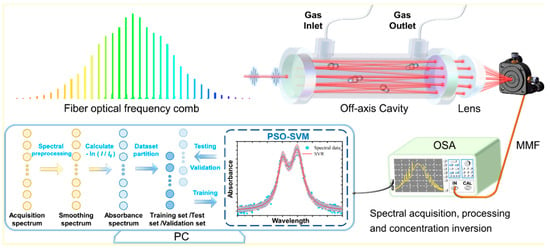
Figure 14.
Schematic of the OACE-FCS dual-gas sensing system.
In summary, this section reviews fiber optic gas sensing technologies for laboratory environments in smart campuses, focusing on refractive index change-based sensors, photoacoustic fiber sensors, and FBG-based sensors. These approaches demonstrate high sensitivity, robustness, and adaptability for detecting hazardous gases such as NH3, CO2, ethanol, and H2S, making them suitable for ensuring safety and environmental compliance in complex laboratory settings. While these technologies show strong performance at the experimental level, their large-scale integration into campus infrastructures requires further development of calibration protocols, system interfaces, and cost-effective deployment strategies. Looking ahead, combining OFS gas sensing with AI-driven anomaly detection, digital twin platforms, and distributed monitoring networks could enhance real-time diagnostics, predictive maintenance, and proactive safety management. Thus, fiber optic gas sensing not only addresses immediate laboratory safety challenges but also supports the broader goal of building sustainable, intelligent, and resilient smart campuses.
5. OFSs for Smart Security and Intrusion Detection in Campus Environments
Security and intrusion detection are critical components of smart campus infrastructure. Ensuring the physical safety of students, faculty, and institutional assets requires comprehensive, real-time monitoring solutions that are resilient, scalable, and capable of operating in diverse environmental conditions. OFS technology offers a unique advantage in this domain through its capacity for long-range, distributed, and tamper-resistant monitoring. In campus perimeter and fence systems, distributed vibration sensing (DVS) based on phase-sensitive optical time-domain reflectometry (phi-OTDR) allows detection of minute vibrations or disturbances caused by attempted intrusions. Optical fibers can be laid along fences, buried underground, or embedded into building facades to detect climbing, digging, cutting, or impact-related activities. These systems are capable of real-time localization of intrusion points with meter-scale resolution, enabling immediate situational awareness and automated response from campus security systems. Within buildings, OFSs can be installed in corridors, stairwells, and emergency exits to monitor human movement patterns and detect unauthorized access, especially in restricted or sensitive zones such as data centers, laboratories, or server rooms. When integrated with artificial intelligence and video surveillance systems, OFS-based motion detection enhances the accuracy and reliability of behavioral monitoring without requiring cameras in privacy-sensitive areas. Another key application is in utility tunnels and underground cable routes, where physical damage or tampering can be detected through DAS. These systems provide continuous, real-time monitoring over long distances with minimal maintenance needs. Unlike traditional intrusion alarms that depend on electrical power and frequent recalibration, OFSs are passive, immune to EMI, and capable of operating in extreme environmental conditions, making them highly reliable for mission-critical security monitoring.
Overall, the integration of OFSs into campus security architecture provides a robust, scalable, and low-visibility solution that enhances perimeter security, protects vital infrastructure, and supports intelligent threat assessment and response. As smart campuses evolve toward more autonomous and data-driven security management systems, OFS technology is poised to play a foundational role in enabling real-time situational awareness and proactive safety assurance.
5.1. Perimeter Security Using Distributed Vibration Sensing
Perimeter security is a fundamental layer of protection in smart campus environments, where early detection of unauthorized intrusions is essential to safeguarding students, faculty, and infrastructure. Traditional security systems—such as infrared sensors, surveillance cameras, and motion detectors—often suffer from blind spots, high false alarm rates, or limited coverage in complex outdoor settings. Distributed Vibration Sensing (DVS), enabled by phase-sensitive optical time-domain reflectometry (ϕ-OTDR), offers a compelling alternative by turning optical fibers into continuous, kilometer-scale sensing elements. When deployed along campus fences, walls, or buried zones, DVS systems can detect and localize vibrations caused by climbing, cutting, digging, or other suspicious activities in real time. This passive, tamper-resistant technology enables continuous 24/7 monitoring with high spatial resolution, making it especially suitable for large, open, or perimeter-critical campus areas.
In 1988, J.P. Dakin and colleagues developed a hybrid interferometric configuration that combined a Sagnac loop with a Mach–Zehnder interferometer to perform disturbance localization experiments [72]. In their setup, a 200-m-long optical fiber forming the Sagnac loop was wound onto a spool, and localized thermal perturbations—both cooling and heating—were applied at various positions on the spool using a small cryogenic spray. Measurements revealed a linear relationship between the output signals of the two interferometers and the position of the applied disturbance, achieving a localization accuracy of approximately 20 m. In 2008, Dongfang Wu and his team at Fudan University proposed an improved optical fiber Sagnac interferometer designed as a distributed sensor for detecting subtle external stress disturbances [73]. The system enables simultaneous localization of disturbances applied at two different points along the sensing fiber, while retaining the advantages of the traditional Sagnac interferometer—most notably, the absence of a requirement for loop fiber shielding. In the experiment, the system’s output was analyzed using Fast Fourier Transform (FFT) and further processed with wavelet transformation. Experimental results demonstrated that, for a 25 km-long fiber and disturbance signals with bandwidths below 20 kHz, the system achieved an average localization error of approximately 59 m. In 2014, Wang et al. introduced an improved intrusion localization method termed “twice-FFT” for distributed Sagnac fiber sensing systems [74]. This approach applies a second fast Fourier transform to the frequency spectrum of the phase signal caused by intrusions, enabling more accurate identification of null frequencies. By fitting and identifying peak frequencies in the twice-FFT curve, the system reliably determines intrusion locations. Experimental results show that this method achieves a location error of less than 100 m over a 41 km sensing range for single-point intrusions and can distinguish two or more intrusions occurring simultaneously. The algorithm enhances multi-point detection capability and demonstrates improved stability, precision, and practicality for real-world intrusion monitoring, the Experimental setup as shown in Figure 15. In 2019, Teng Fei and colleagues from Shenzhen University proposed a distributed optical fiber sensor based on a dual Sagnac interferometer configuration, along with a frequency–domain “spectral peak ratio” positioning algorithm [75]. Experimental results from both single-point and multi-point localization demonstrated that this structure and algorithm could effectively locate disturbances. On a 1.3 km fiber link, the system achieved a spatial resolution better than 15 m. In 2025, Zhenshi Sun et al. proposed a long-range distributed fiber optic disturbance sensing system based on a stationary wavelet transform (SWT) and Mach–Zehnder interferometer configuration [76]. The method exploits light phase modulation theory, using Hilbert and IIR filtering to isolate high-frequency signal components and suppress spectral asymmetry. A SWT-based algorithm extracts time–frequency variation envelopes, followed by a generalized cross-correlation method to determine fixed time delays between signals. This enables precise localization of disturbances. Experimental validation on an 81 km fiber link achieved a mean positioning error of 18.5 m with a processing time of only 0.12 s, demonstrating strong potential for real-time, high-accuracy sensing in long-distance security monitoring applications, as shown in Figure 16.

Figure 15.
Experimental setup of the distributed Sagnac intrusion detection system.
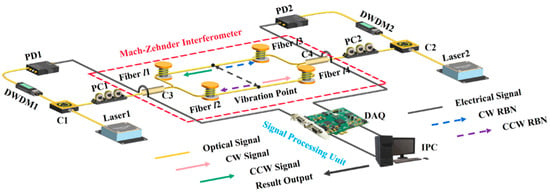
Figure 16.
System diagram of an inline asymmetric Mach–Zehnder interferometer-based long-range DFODS system.
5.2. Underground Facility Protection via Distributed Acoustic Sensing
Underground infrastructure—such as power lines, communication cables, water supply pipelines, and utility tunnels—forms the operational backbone of modern smart campuses. However, these facilities are often vulnerable to undetected failures, accidental damage, or even malicious tampering. Distributed Acoustic Sensing (DAS) offers a powerful, real-time solution for monitoring and protecting these hidden assets. By utilizing the intrinsic scattering properties of standard optical fibers, DAS transforms a single fiber into a dense array of virtual microphones capable of detecting acoustic disturbances along its entire length. This enables the identification and localization of abnormal activities such as digging, mechanical impact, leakage, or cable vibration with high spatial resolution. Unlike traditional underground monitoring systems that require discrete sensors and power sources, DAS systems are entirely passive, immune to electromagnetic interference, and well-suited for harsh environments. As smart campuses grow increasingly reliant on secure, uninterrupted infrastructure, the deployment of DAS becomes critical to achieving resilient and intelligent underground facility management.
In 2009, Tanimola et al. introduced a technology in the United Kingdom based on high-fidelity distributed fiber optic acoustic sensing for real-time leak detection in oil and gas pipelines [77]. The study detailed the sensing principle and technical advantages of the fiber optic acoustic sensor, demonstrating its capability to accurately detect and locate gas pipeline leaks. In 2018, Pavol et al. adopted a method in which distributed sensing fibers were helically wound around pipelines to enhance both the spatial resolution and sensitivity of the system [78]. Experimental results showed that the distributed acoustic sensing (DAS) system based on fiber winding could effectively detect pipeline vibration signals induced by leakage. The system demonstrated the capability to sense vibration patterns with acceleration levels as low as 1 μg, as illustrated in Figure 17. In 2023, Li Bo et al. proposed a leak detection and safety warning system based on DAS [79]. The system is capable of promptly identifying and accurately locating leaks in high-sulfur natural gas pipelines, enabling comprehensive and real-time safety protection. This approach significantly enhances the efficiency of emergency response and leak mitigation. In 2023, Song et al. proposed a branch localization method based on a fiber optic linear Sagnac interferometer [80]. The system employs dual-wavelength single-core fiber to demodulate external disturbances. Multiple branches are extended along the sensing cable, and a zero-frequency method is used to determine whether the disturbance originates from the main path or a specific branch. This provides a simple and effective solution for branch localization in distributed fiber optic sensing applications. As illustrated in Figure 18, the diagram shows the principle of branch localization using a linear Sagnac interferometer-based fiber sensor system.
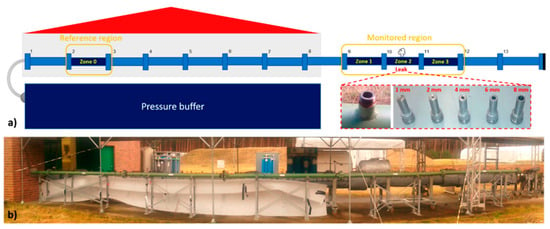
Figure 17.
(a) Pipeline schematic with OFS zones and simulated leak adapters; (b) photograph of the test pipeline setup with fiber instrumentation.
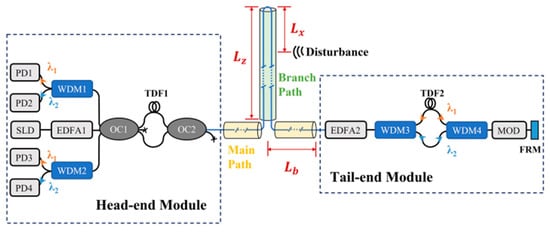
Figure 18.
Schematic diagram of a fiber optic sensor based on a linear Sagnac interferometer for branch localization.
5.3. Integration of OFS with AI and Surveillance Systems
As smart campuses evolve toward more autonomous and intelligent security ecosystems, the integration of OFS technology with artificial intelligence (AI) and surveillance systems has emerged as a promising direction. While OFSs provide high-resolution, real-time data on physical disturbances and environmental changes, their full potential is realized when combined with AI-driven analytics for event classification, anomaly detection, and threat prediction. For instance, vibration or acoustic signals captured by distributed sensing networks can be analyzed using machine learning algorithms to distinguish between benign activities and security threats. Furthermore, integration with video surveillance systems enables multi-modal situational awareness, where optical fiber data can trigger or augment camera-based monitoring in privacy-sensitive or hard-to-reach areas. This synergy enhances the accuracy, scalability, and responsiveness of campus-wide security systems, paving the way for proactive, adaptive safety management in educational environments.
In 2010, Jiang et al. proposed an intrusion detection method using a Mach–Zehnder distributed OFS system [81]. The method combines wavelet packet transform for feature extraction with a back propagation (BP) neural network for signal classification. After preprocessing the time–domain signals through segmentation and wavelet threshold denoising, time–frequency features are extracted and used for training the BP network. Outdoor experiments showed the system achieved a recognition rate of 96.8% for human walking, vehicle movement, and animal crawling events. In 2019, Zhenshi Sun et al. developed a fiber optic perimeter security system based on dual Mach–Zehnder interferometers (DMZI) [82]. To address the challenge of discriminating highly similar vibration signals, they proposed a feature extraction method that combines Variational Mode Decomposition (VMD) with zero-crossing rate analysis, followed by intrusion classification using a Support Vector Machine (SVM) classifier. This approach represents an early application of AI-driven techniques in optical fiber sensing, where machine learning algorithms play a central role in feature selection and intelligent event recognition. Experimental results demonstrated that the system achieved an average recognition rate of 96.9% for three types of human-induced intrusion events, significantly outperforming conventional Empirical Mode Decomposition (EMD)-based methods. Figure 19 illustrates the schematic diagram of the DMZI-based vibration sensing system. In 2023, Kang Xue et al. from Tianjin University combined a dual Mach–Zehnder distributed fiber sensing system with a quadrotor UAV platform and proposed an event classification method using the YOLOv5s model [83]. The one-dimensional time-domain signals were converted into two-dimensional time–frequency images via Short-Time Fourier Transform (STFT) and fed into the YOLOv5s model for training and classification. Experiments showed that the method achieved over 95% accuracy in identifying five types of events. In 2025, Zhenshi Sun et al. proposed an ameliorated positioning scheme for optical fiber interferometer-based vibration sensors, aiming at long-range perimeter security monitoring, as shown in Figure 20 [84]. The study highlights the role of advanced signal processing—in particular, multivariate variational mode decomposition (MVMD)—to reduce computational complexity and enhance localization accuracy without extra hardware. From a broader perspective, this work illustrates how AI-inspired algorithms and data-driven feature extraction can be embedded into OFS systems, enabling real-time vibration detection and precise localization across distances exceeding 100 km. Such integration underscores the growing trend of combining optical fiber interferometry with intelligent signal processing, bridging conventional photonics with machine learning approaches to support scalable, resilient, and smart sensing infrastructures. In 2025, Xiangjun Xin et al. introduced advanced modulation techniques to improve signal integrity and noise resilience in OFS, particularly for multi-parameter sensing [85]. They further proposed machine learning-based methods to enhance transmission in novel fiber types, highlighting the potential of AI–OFS integration in smart campuses. Their work also explored neural networks for optimizing optical amplification, providing insights for future OFS system design and performance improvement [86].
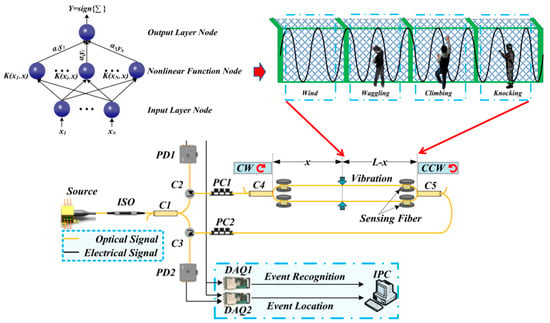
Figure 19.
Schematic diagram of DMZI-based vibration sensing system.
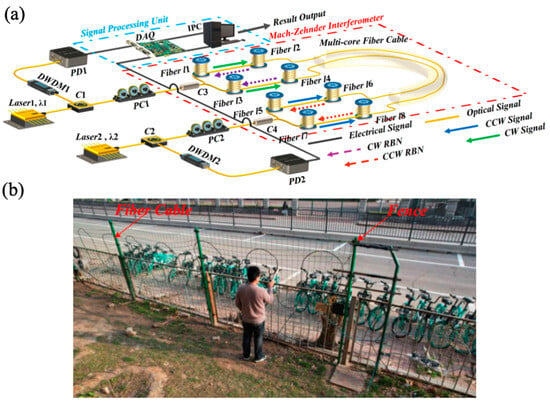
Figure 20.
(a) Schematic of annular asymmetry dual MZI-based sensor for long-distance vibration localization; (b) experimental scenario of disturbing the fiber cable on the fence.
The application of OFS technology in campus security and intrusion detection represents a transformative shift from traditional, limited coverage monitoring systems toward comprehensive, intelligent, and resilient solutions. Leveraging techniques such as DVS and DAS, OFS systems enable real-time, long-distance, and high-resolution detection of security events across campus perimeters, underground infrastructure, and indoor sensitive areas. Historical and recent advances in Sagnac interferometers, Mach–Zehnder configurations, and novel frequency–domain algorithms—such as twice-FFT and SWT-based methods—have significantly enhanced the accuracy, spatial resolution, and processing efficiency of intrusion localization systems. Furthermore, the integration of OFS data with artificial intelligence (AI) and surveillance platforms enables multi-modal situational awareness, advanced event classification, and predictive analytics, improving the responsiveness and autonomy of campus safety management. Research involving machine learning models (e.g., BP networks, SVM, YOLOv5s) has demonstrated high recognition accuracy for intrusion patterns, human activities, and environmental disturbances. These innovations not only improve detection capability but also enable intelligent decision-making in real time.
In summary, the application of optical fiber sensing (OFS) technology in smart campus security and intrusion detection marks a significant advancement beyond traditional monitoring systems. By leveraging techniques such as distributed vibration sensing (DVS) and distributed acoustic sensing (DAS), OFS enables real-time, long-distance, and high-resolution detection of intrusion events across perimeters, underground infrastructure, and indoor sensitive zones. Advances in interferometric configurations—including Sagnac and Mach–Zehnder systems—combined with signal processing algorithms such as twice-FFT and stationary wavelet transform (SWT), have enhanced localization accuracy, spatial resolution, and detection stability. Furthermore, integration with artificial intelligence (AI) and surveillance systems provides multi-modal situational awareness, enabling intelligent event classification, anomaly detection, and predictive threat assessment. Research applying machine learning approaches, including BP neural networks, SVM, and YOLOv5s, has achieved high recognition accuracy for intrusion and activity patterns. Collectively, these developments establish OFS as a scalable, resilient, and intelligent foundation for next-generation campus safety management.
6. Summary, Challenges, and Prospects
6.1. Summary
The OFS technology has emerged as a highly promising solution for enabling intelligent perception and real-time monitoring within smart campus environments. This review has systematically examined its diverse applications across several key domains, including structural health monitoring of campus buildings, environmental sensing in laboratories, and intelligent perimeter and facility security. The intrinsic advantages of OFS—such as high sensitivity, passive operation, electromagnetic immunity, and distributed sensing capability—make it particularly suitable for complex and multi-scenario campus deployments. In addition, the compatibility of OFS with various communication protocols and data platforms allows for seamless integration with existing digital infrastructures. The ability to embed OFS sensors into buildings, utility tunnels, and critical equipment provides a non-intrusive and long-term monitoring solution that aligns with the goals of campus safety, operational efficiency, and sustainability. Moreover, the combination of OFS with AI-based data processing and cloud-edge architectures further enhances its value in smart campus construction.
6.2. Challenges and Prospects
While the potential of OFS technology in smart campuses is substantial, several challenges must be addressed to facilitate its broader adoption. Technically, the precision and stability of sensors over long-term deployment, environmental cross-sensitivity, and the need for more robust sensor packaging remain significant obstacles. From an engineering perspective, the complexity and cost associated with fiber deployment, as well as the maintenance of large-scale sensing networks, may hinder practical implementation in legacy infrastructure.
Another key issue lies in the lack of standardized protocols for OFS data acquisition, fusion, and visualization, which impedes interoperability between systems and limits scalability. Additionally, the current gap between sensing data and actionable intelligence highlights the need for advanced signal processing techniques and intelligent decision-support systems.
Looking ahead, future research should prioritize the development of low-cost, miniaturized, and multifunctional fiber sensors, as well as the design of unified platforms that integrate sensing, communication, and analytics. The convergence of OFS with emerging technologies—such as machine learning, edge computing, and digital twin frameworks—will be instrumental in overcoming current limitations. Ultimately, OFS is expected to play a foundational role in the evolution of smart campus infrastructure, contributing to more resilient, intelligent, and adaptive educational ecosystems.
Author Contributions
Conceptualization, X.Z. and J.S.; methodology, X.Z. and J.S.; investigation, X.Z. and H.Z.; resources, X.Z. and H.Z.; writing—original draft preparation, X.Z. and H.Z.; writing—X.Z. and H.Z.; supervision, X.Z.; project administration, X.Z.; funding acquisition, X.Z. and J.S. All authors have read and agreed to the published version of the manuscript.
Funding
This research was funded by the National Natural Science Foundation (72574076) and Key Scientific Research Projects of Higher Education Institutions in Henan Province (26A50002).
Data Availability Statement
The original contributions presented in this study are included in the article. Further inquiries can be directed to the corresponding author.
Conflicts of Interest
The authors declare no conflicts of interest.
References
- Zhai, X.; Chu, X.; Chai, C.S.; Jong, M.S.Y.; Istenic, A.; Spector, M.; Liu, J.B.; Yuan, J.; Li, Y. A Review of Artificial Intelligence (AI) in Education from 2010 to 2020. Complexity 2021, 2021, 8812542. [Google Scholar] [CrossRef]
- Fu, Y.; Liu, Y.; Song, W.; Yang, D.; Wu, W.; Lin, J.; Yang, X.; Zeng, J.; Rong, L.; Xia, J.; et al. Early monitoring-to-warning Internet of Things system for emerging infectious diseases via networking of light-triggered point-of-care testing devices. Exploration 2023, 3, 20230028. [Google Scholar] [CrossRef] [PubMed]
- Xu, S.; Liu, Y.; Lee, H.; Li, W. Neural interfaces: Bridging the brain to the world beyond healthcare. Exploration 2024, 4, 20230146. [Google Scholar] [CrossRef]
- Polin, K.; Yigitcanlar, T.; Limb, M.; Washington, T. The making of smart campus: A review and conceptual framework. Buildings 2023, 13, 891. [Google Scholar] [CrossRef]
- Omotayo, T.; Moghayedi, A.; Awuzie, B.; Ajayi, S. Infrastructure elements for smart campuses: A bibliometric analysis. Sustainability 2021, 13, 7960. [Google Scholar] [CrossRef]
- Schnarre, E.; Appiah-Opoku, S.; Weber, J.; Jones, S. Improving mobility and infrastructural connectivity on college campus for commuting students: A case study from the US. Urban Plan. Transp. Res. 2022, 10, 466–482. [Google Scholar]
- Zheng, R.; Ma, H.; Wang, Q.; Fu, J.; Jiang, Z. Assessing the security of campus networks: The case of seven universities. Sensors 2021, 21, 306. [Google Scholar] [CrossRef]
- Bao, X.; Chen, L. Recent progress in Brillouin scattering based fiber sensors. Sensors 2011, 11, 4152–4187. [Google Scholar] [CrossRef]
- Yang, H.; Tatel, G.; Wang, Y.; Yang, J.; Chen, L.; Bao, X. Polarization-maintaining fiber loop mirror-based ultrasound sensing technique with enhanced signal-to-noise ratio. IEEE Sens. J. 2023, 23, 27293–27299. [Google Scholar]
- Bao, X.; Chen, L. Recent progress in distributed fiber optic sensors. Sensors 2012, 12, 8601–8639. [Google Scholar] [CrossRef]
- Li, Z.; Wang, S.; Shao, Z.; Jiang, J.; Yan, M.; Sun, Z.; Yang, H.; Dai, X.; Liu, T. High-Speed and Error-Suppressed Fiber-Optic F–P System for Dynamic Pressure Measurement at High Temperature. IEEE Sens. J. 2023, 24, 4274–4280. [Google Scholar] [CrossRef]
- Pendão, C.; Silva, I. Optical fiber sensors and sensing networks: Overview of the main principles and applications. Sensors 2022, 22, 7554. [Google Scholar] [CrossRef] [PubMed]
- Sun, Z.; Sun, D.; Yang, H.; Zhao, C. Distributed optical fiber vibration sensors using light interference technology: Fundamental principles and major advancements. IEEE Trans. Instrum. Meas. 2025, 74, 7501227. [Google Scholar] [CrossRef]
- Miliou, A. In-fiber interferometric-based sensors: Overview and recent advances. Photonics 2021, 8, 265. [Google Scholar]
- Yang, H.; Wang, S.; Liu, K.; Jiang, J.; Li, Y.; Li, Z.; Zhang, P.; Dai, X.; Liu, T. Real-time self-calibrating phase-shifted demodulation method based on polarized low-coherence interference for optical fiber acoustic sensor. IEEE Sens. J. 2022, 22, 8537–8543. [Google Scholar]
- Chew, J.W.; Gan, S.X.; Cui, J.; Chan, W.D.; Chu, S.T.; Tam, H.Y. Recent Advancements in Optical Fiber Sensors for Non-Invasive Arterial Pulse Waveform Monitoring Applications: A Review. Photonics 2025, 12, 662. [Google Scholar] [CrossRef]
- Li, Z.; Wang, S.; Shao, Z.; Jiang, J.; Yang, H.; Sun, Z.; Yan, M.; Liu, T. Rapid and wide-range pressure measurement at high-temperature using an intensity-compensation interrogation method. Opt. Lasers Eng. 2022, 157, 107116. [Google Scholar] [CrossRef]
- Sun, Z.; Li, S.; Yang, H. Precise disturbance localization of long-distance fiber interferometer vibration senor based on an improved time–frequency variation feature extraction scheme. Infrared Phys. Technol. 2024, 137, 105097. [Google Scholar] [CrossRef]
- Sun, Z.; Huang, D.; Li, S.; Yang, H.; Zhao, C. High-efficiency positioning of vibration intrusions for long-distance perimeter security monitoring based on time-frequency variation envelopes. IEEE Trans. Instrum. Meas. 2024, 73, 1–11. [Google Scholar] [CrossRef]
- Cai, Y.; Yan, W.; Liu, H.; Sun, Y.; Zhou, X. Security monitoring of smart campus using distributed fiber optic acoustic sensing. In AOPC 2020: Optical Information and Network; SPIE: Bellingham, WA, USA, 2020; Volume 11569, pp. 109–117. [Google Scholar]
- Haolun, L. A Real-time Seating Monitoring System for Smart Campuses Based on Quasi-distributed Weak Fiber Bragg Grating Array. Int. J. Front. Eng. Technol. 2023, 5, 12. [Google Scholar]
- Yang, H.; Wang, S.; Liu, K.; Fang, C.; Li, Z.; Zhang, J.; Liu, T. Whisker array based on fiber Bragg grating for surface shape sensing. In Proceedings of the 2021 International Conference on Optical Instruments and Technology: Optical Sensors and Applicationss, Online, 8–10 April 2022; SPIE: Bellingham, WA, USA, 2022; Volume 12279, pp. 20–28. [Google Scholar]
- Chen, A.; Wang, S.; Hou, L.; Li, Z.; Li, X.; Yang, H.; Li, T.; Du, X.; Jiang, J.; Liu, K.; et al. Highly Sensitive Graphene Oxide-Based Fabry-Perot Low-Frequency Acoustic Sensor with Low-Coherence Polarized Demodulation Using Three-Step Phase-Shifting Arctan Algorithms. J. Light. Technol. 2024, 42, 6115–6123. [Google Scholar] [CrossRef]
- Huot, F.; Clapp, R.G.; Biondi, B.L. Detecting local earthquakes via fiber-optic cables in telecommunication conduits under Stanford University campus using deep learning. Comput. Geosci. 2024, 190, 105625. [Google Scholar] [CrossRef]
- Domingues, M.F.F.; Radwan, A. Optical fiber sensors in IoT. In Optical Fiber Sensors for IoT and Smart Devices; Springer International Publishing: Cham, Switzerland, 2017; pp. 73–86. [Google Scholar]
- Sun, Z.; Yang, Q.; Yang, H.; Xue, K.; Fang, P. An intelligent model integrating multi-scale features and end-to-end classifier for accurate events recognition along fiber optic fence. Infrared Phys. Technol. 2025, 145, 105740. [Google Scholar] [CrossRef]
- Sailer, D.R. Planning for fiber optic use at the University of Massachusetts. In FDDI, Campus-Wide, and Metropolitan Area Networks; SPIE: Bellingham, WA, USA, 1991; Volume 1364, pp. 257–261. [Google Scholar]
- Yang, H.; Tatel, G.; Wang, Y.; Chen, L.; Bao, X. Fabrication of elliptical-silica microfiber for ultrasound detection. Opt. Lett. 2024, 49, 1929–1932. [Google Scholar] [CrossRef] [PubMed]
- You, Y.; Liu, W.; Zhang, S.; Wu, J.; Li, Y.; Shi, H.; Yang, H. Single-Polarization Single-Mode Hollow-Core Anti-Resonant Fiber with Low Loss and Wide Bandwidth. Photonics 2025, 12, 686. [Google Scholar] [CrossRef]
- Zhang, P.; Wang, S.; Jiang, J.; Li, Z.; Yang, H.; Liu, T. A fiber-optic accelerometer based on extrinsic Fabry-Perot interference for low frequency micro-vibration measurement. IEEE Photonics J. 2022, 14, 1–6. [Google Scholar] [CrossRef]
- Li, Z.; Wang, S.; Jiang, J.; Yang, H.; Zhang, P.; Dai, X.; Li, X.; Liu, T. Intensity self-compensation method against multi-factors for polarization-based Fabry–Perot interrogation system. Opt. Lett. 2022, 47, 6313–6316. [Google Scholar] [CrossRef]
- Claus, R.O. Overview of fiber optics and smart structures programs at Virginia Tech. Fiber Optic Smart Struct. Skins II 1990, 1170, 109–112. [Google Scholar]
- Yang, H.; Wang, S. High-robustness polarization-based optical fiber Fabry-Perot microphone. In Proceedings of the Asia-Pacific Optical Sensors Conference (APOS 2023), Munich, Germany, 30 July–3 August 2023; SPIE: Bellingham, WA, USA, 2023; Volume 12813, pp. 57–60. [Google Scholar]
- Hubbard, P.G.; Xu, J.; Zhang, S.; Dejong, M.; Luo, L.; Soga, K.; Papa, C.; Zulberti, C.; Malara, D.; Fugazzotto, F.; et al. Dynamic structural health monitoring of a model wind turbine tower using distributed acoustic sensing (DAS). J. Civ. Struct. Health Monit. 2021, 11, 833–849. [Google Scholar] [CrossRef]
- Gorshkov, B.G.; Yüksel, K.; Fotiadi, A.A.; Wuilpart, M.; Korobko, D.A.; Zhirnov, A.A.; Stepanov, K.V.; Turov, A.T.; Konstantinov, Y.A.; Lobach, I.A. Scientific applications of distributed acoustic sensing: State-of-the-art review and perspective. Sensors 2022, 22, 1033. [Google Scholar] [CrossRef]
- Sun, Z.; Fang, M.; Dai, Y.; Yang, H. Identification of Multiple Events Based on Two-Dimensional Images and Isotropic Network in Optical Fiber Perimeter Security System. IEEE Sens. J. 2024, 24, 23859–23869. [Google Scholar] [CrossRef]
- Xie, Z.; Sun, Y.; Lv, A.; Xu, Q. Measurement and evaluation method of distributed optical fiber acoustic sensing performance. Photonics 2024, 11, 166. [Google Scholar] [CrossRef]
- Farrar, C.R.; Worden, K. An introduction to structural health monitoring. Philos. Trans. R. Soc. A Math. Phys. Eng. Sci. 2007, 365, 303–315. [Google Scholar]
- Hassani, S.; Mousavi, M.; Gandomi, A.H. Structural health monitoring in composite structures: A comprehensive review. Sensors 2021, 22, 153. [Google Scholar] [CrossRef]
- Yang, H.; Wang, S.; Liu, K.; Jiang, J.; Li, Z.; Dai, X.; Li, X.; Zhang, P.; Liu, T. High-stability polarization-based interrogation method with cross-correlation for optical fiber interferometric acoustic sensors. J. Light. Technol. 2023, 41, 4481–4488. [Google Scholar] [CrossRef]
- Sun, Z.; Yang, H.; Fang, M.; Dai, Y.; Huang, D.; Zhao, C. On Bayesian optimization-based CNN-BiLSTM network for multi-class classification in distributed optical fiber vibration sensing systems. IEEE Trans. Instrum. Meas. 2024, 73, 7006414. [Google Scholar]
- Guo, H.; Xiao, G.; Mrad, N.; Yao, J. Fiber optic sensors for structural health monitoring of air platforms. Sensors 2011, 11, 3687–3705. [Google Scholar] [CrossRef]
- Hasan, M.R.; Akter, S.; Rifat, A.A.; Rana, S.; Ali, S. A highly sensitive gold-coated photonic crystal fiber biosensor based on surface plasmon resonance. Photonics 2017, 4, 18. [Google Scholar] [CrossRef]
- Riza, M.A.; Go, Y.I.; Harun, S.W.; Maier, R.R. FBG sensors for environmental and biochemical applications—A review. IEEE Sens. J. 2020, 20, 7614–7627. [Google Scholar]
- Yang, H.; You, H.; He, J. Optical fiber sensing and reconstruction method for flexible tentacle shape of robot. Laser Infrared 2020, 50, 1246–1252. [Google Scholar]
- Brindisi, A.; Vendittozzi, C.; Travascio, L.; Di Palma, L.; Ignarra, M.; Fiorillo, V.; Concilio, A. A preliminary assessment of an FBG-based hard landing monitoring system. Photonics 2021, 8, 450. [Google Scholar] [CrossRef]
- Guo, Y.X.; Liu, W.L.; Xiong, L.; Kuang, Y.; Wu, H.; Liu, H. Fiber Bragg Grating displacement sensor with high abrasion resistance for a steel spring floating slab-damping track. Sensors 2018, 18, 1899. [Google Scholar] [CrossRef]
- Wang, S.; Zhu, L.Q.; Xin, J.T.; Dong, M.L. Fiber Grating Displacement Sensor of Tape Measure Structure. Opt. Fiber Technol. 2020, 54, 102107. [Google Scholar] [CrossRef]
- Kim, S.W.; Yun, D.W.; Park, D.U.; Chang, S.J.; Park, J.B. Vehicle load estimation using the reaction force of a vertical displacement sensor based on fiber brag grating. Sensors 2022, 22, 5355. [Google Scholar]
- Li, G. Research on Crack Monitoring Based on Double Cantilever Beam FBG Displacement Sensor. Master’s Thesis, College of Disaster Prevention Science and Technology, Sanhe, China, 2024. [Google Scholar]
- Froggatt, M.; Moore, J. High-spatial-resolution distributed strain measurement in optical fiber with Rayleigh scatter. Appl. Opt. 1998, 37, 1735–1740. [Google Scholar] [CrossRef]
- Zhou, D.-P.; Qin, Z.; Li, W.; Chen, L.; Bao, X. Distributed vibration sensing with time-resolved optical frequency-domain reflectometry. Opt. Express 2012, 20, 13138–13145. [Google Scholar] [CrossRef] [PubMed]
- Kim, Y.; Kim, M.J.; Rho, B.S.; Kim, Y.H. Measurement range enhancement of Rayleigh-based optical frequency domain reflectometry with bidirectional determination. IEEE Photonics J. 2017, 9, 1–8. [Google Scholar] [CrossRef]
- Lin, S.Q.; Tan, D.Y.; Yin, J.H.; Zhu, H.H.; Kong, Y. Distributed fiber optic sensing for micro-and macro-crack quantification: An interfacial-fracture-energy-based model. Struct. Health Monit. 2024, 23, 2815–2833. [Google Scholar] [CrossRef]
- Siivola, J.T.; Minakuchi, S.; Mizutani, T.; Takeda, N. Evaluation of damage detectability in practical sandwich structure application conditions using distributed fiber optic sensor. Struct. Health Monit. 2016, 15, 3–20. [Google Scholar] [CrossRef]
- Califano, A.; Chandarana, N.; Grassia, L.; D’Amore, A.; Soutis, C. Damage detection in composites by artificial neural networks trained by using in situ distributed strains. Appl. Compos. Mater. 2020, 27, 657–671. [Google Scholar] [CrossRef]
- Tan, X.; Mahjoubi, S.; Zou, X.; Meng, W.; Bao, Y. Metaheuristic inverse analysis on interfacial mechanics of distributed fiber optic sensors undergoing interfacial debonding. Mech. Syst. Signal Process. 2023, 200, 110532. [Google Scholar] [CrossRef]
- Yao, B.; Wu, Y.U.; Cheng, Y.; Zhang, A.; Gong, Y.; Rao, Y.J.; Wang, Z.G.; Chen, Y. All-optical Mach–Zehnder interferometric NH3 gas sensor based on graphene/microfiber hybrid waveguide. Sens. Actuators B Chem. 2014, 194, 142–148. [Google Scholar] [CrossRef]
- Quan, M.; Tian, J.; Yao, Y. Ultra-high sensitivity Fabry–Perot interferometer gas refractive index fiber sensor based on photonic crystal fiber and Vernier effect. Opt. Lett. 2015, 40, 4891–4894. [Google Scholar] [CrossRef] [PubMed]
- Chu, R.; Guan, C.; Bo, Y.; Shi, J.; Zhu, Z.; Li, P.; Yang, J.; Yuan, L. All-optical graphene-oxide humidity sensor based on a side-polished symmetrical twin-core fiber Michelson interferometer. Sens. Actuators B Chem. 2019, 284, 623–627. [Google Scholar] [CrossRef]
- Chen, G.; Li, J.; Zhu, H.; Wang, Y.; Ji, H.; Meng, F. Optical fiber gas sensor with multi-parameter sensing and environmental anti-interference performance. J. Ind. Inf. Integr. 2024, 38, 100565. [Google Scholar] [CrossRef]
- Peng, Y.; Zhang, W.; Li, L.; Yu, Q. Tunable fiber laser and fiber amplifier based photoacoustic spectrometer for trace gas detection. Spectrochim. Acta A Mol. Biomol. Spectrosc. 2009, 74, 924–927. [Google Scholar] [CrossRef]
- Chen, K.; Gong, Z.; Yu, Q. Fiber-amplifier-enhanced resonant photoacoustic sensor for sub-ppbv level acetylene detection. Sens. Actuators A Phys. 2018, 274, 184–188. [Google Scholar] [CrossRef]
- Zhao, X.; Wang, Z.; Li, C.; Wang, H.; Qi, H.; Guo, M.; Ma, F.X.; Chen, K. Ultrahigh sensitive trace gas sensing system with dual fiber-optic cantilever multiplexing-based differential photoacoustic detection. Anal. Chem. 2024, 96, 1046–1053. [Google Scholar] [CrossRef]
- He, Y.; Ma, Y.; Tong, Y.; Yu, X.; Tittel, F.K. HCN ppt-level detection based on a QEPAS sensor with amplified laser and a miniaturized 3D-printed photoacoustic detection channel. Opt. Express 2018, 26, 9666–9675. [Google Scholar] [CrossRef] [PubMed]
- Wang, F.P.; Xue, Q.S.; Chang, J.; Wang, Z.L.; Sun, J.C.; Luan, X.N.; Li, C. Wavelength scanning Q-switched fiber-ring laser intra-cavity QEPAS using a standard 32.76 kHz quartz tuning fork for acetylene detection. Opt. Laser Technol. 2021, 134, 106612. [Google Scholar] [CrossRef]
- Wang, Z.; Wang, Q.; Zhang, H.; Borri, S.; Galli, I.; Sampaolo, A.; Patimisco, P.; Spagnolo, V.L.; De, N.P.; Ren, W. Doubly resonant sub-ppt photoacoustic gas detection with eight decades dynamic range. Photoacoustics 2022, 27, 100387. [Google Scholar] [CrossRef] [PubMed]
- Debliquy, M.; Renoirt, J.M.; Caucheteur, C.; Mégret, P.; Olivier, M.G. Volatile organic compounds detection with tilted fiber Bragg gratings coated by ZnO nanoparticles. In Optical Sensing and Detection II; SPIE: Bellingham, WA, USA, 2012; Volume 8439, pp. 647–654. [Google Scholar]
- Bueno, A.; Debliquy, M.; Lahem, D.; Van Baekel, A.; Mégret, P.; Caucheteur, C. NO2 optical fiber sensor based on TFBG coated with LuPc2. In Proceedings of the SENSORS 2014, Valencia, Spain, 2–5 November 2014; IEEE: Piscataway, NJ, USA, 2014; pp. 1073–1076. [Google Scholar]
- Cai, S.; Liu, F.; Wang, R.; Xiao, Y.; Li, K.; Caucheteur, C.; Guo, T. Narrow bandwidth fiber-optic spectral combs for renewable hydrogen detection. Sci. China Inf. Sci. 2020, 63, 222401. [Google Scholar] [CrossRef]
- Guan, G.; Liu, A.; Wu, X.; Zheng, C.; Liu, Z.; Zheng, K.; Tittel, F.K. Near-Infrared Off-Axis Cavity-Enhanced Optical Frequency Comb Spectroscopy for CO2/CO Dual-Gas Detection Assisted by Machine Learning. ACS Sens. 2024, 9, 820–829. [Google Scholar] [CrossRef]
- Dakin, J.P.; Pearce, D.A.J.; Strong, A.P.; Wade, C.A. A Novel Distributed Optical Fibre Sensing System Enabling Location of Disturbances in A Sagnac Loop Interferometer: Fiber optic and laser sensors V. In Fiber Optic and Laser Sensors V; SPIE: Bellingham, WA, USA, 1988; pp. 325–328. [Google Scholar]
- Wu, D.F.; Zhang, T.Z.; Jia, B. Modified Sagnac interferometer for distributed disturbance detection. Microw. Opt. Technol. Lett. 2008, 50, 1608–1610. [Google Scholar] [CrossRef]
- Wang, H.; Sun, Q.; Li, X.; Wo, J.; Shum, P.P.; Liu, D. Improved location algorithm for multiple intrusions in distributed Sagnac fiber sensing system. Opt. Express 2014, 22, 7587–7597. [Google Scholar] [CrossRef] [PubMed]
- Teng, F.; Yi, D.; Hong, X.; Li, X. Distributed fiber optics disturbance sensor using a dual-Sagnac interferometer. Opt. Lett. 2019, 44, 5101–5103. [Google Scholar] [CrossRef] [PubMed]
- Sun, Z.; Ma, Z.; Niu, J.; Guo, H.; Zhang, J.; Yang, H. A Stationary Wavelet Transform-Based Positioning Scheme for Long Range Distributed Fiber Optic Disturbance Sensor. IEEE Sens. J. 2025, 25, 21589–21599. [Google Scholar] [CrossRef]
- Tanimola, F.; Hill, D. Distributed fibre optic sensors for pipeline protection. J. Nat. Gas Sci. Eng. 2009, 1, 134–143. [Google Scholar] [CrossRef]
- Stajanca, P.; Chruscicki, S.; Homann, T.; Seifert, S.; Schmidt, D.; Habib, A. DAS Detection of Leak-Induced Pipeline Vibrations Using Fiber-Optic Distributed Acoustic Sensing. Sensors 2018, 18, 2841. [Google Scholar] [CrossRef]
- Li, B. Application of distributed optical fiber leakage detection and safety pre-warning system in natural gas pipeline. Petrochem. Autom. 2023, 59, 60–63, 95. [Google Scholar]
- Song, Y.; Ma, Y.; Lai, X.; Jia, B.; Xiao, Q. Fiber optic sensor based on linear Sagnac interferometer for branch localization. J. Light. Technol. 2023, 41, 6621–6630. [Google Scholar] [CrossRef]
- Jiang, L.H.; Liu, X.M.; Zhang, F. Multi-target recognition used in airport fiber fence warning system. In Proceedings of the 2010 International Conference on Machine Learning and Cybernetics, Qingdao, China, 11–14 July 2010; pp. 1126–1129. [Google Scholar]
- Sun, Z.; Liu, K.; Jiang, J.; Ma, P.; Xu, Z.; Guo, H.; Zhou, Z.; Liu, T. Variational mode decomposition-based event recognition in perimeter security monitoring with fiber optic vibration sensor. IEEE Access 2019, 7, 182580–182587. [Google Scholar] [CrossRef]
- Xue, K.; Liu, K.; Jiang, J.; Wang, S.; Xu, T.; Sun, Z.; Li, S.; Huang, Y.; Jin, X.; Liu, T. Research on accurate detection of optical fiber vibration sensing events based on YOLOv5s model. Acta Opt. Sin. 2023, 43, 0228001. [Google Scholar]
- Sun, Z.; Yang, H.; Zhang, J.; Fang, P.; Zhao, C. An Ameliorated Positioning Scheme for Optical Fiber Interferometer-Based Vibration Sensors in Perimeter Security Monitoring Application. IEEE Trans. Instrum. Meas. 2025, 74, 9512611. [Google Scholar] [CrossRef]
- Wang, S.; Wang, F.; Gao, R.; Guo, D.; Chang, H.; Li, Z.; Pan, X.; Zhou, S.; Zhang, Q.; Xin, X. SNR Enhanced OAM Mode Division Multiplexing with In-Band Noise Modulation Based on Cascade Delta-Sigma Modulation. Opt. Express 2025, 33, 1058–1068. [Google Scholar] [CrossRef] [PubMed]
- Wu, Z.; Gao, R.; Wang, F.; Chang, H.; Li, Z.; Guo, D.; Zhu, L.; Zhang, Q.; Wang, G.; Shen, S.; et al. Inverse Design of Discrete Raman Amplifiers Using an Invertible Neural Network for Ultra-Wideband Optical Transmission Based on Hollow Core Fibers. Opt. Express 2025, 33, 8686–8700. [Google Scholar] [CrossRef] [PubMed]
Disclaimer/Publisher’s Note: The statements, opinions and data contained in all publications are solely those of the individual author(s) and contributor(s) and not of MDPI and/or the editor(s). MDPI and/or the editor(s) disclaim responsibility for any injury to people or property resulting from any ideas, methods, instructions or products referred to in the content. |
© 2025 by the authors. Licensee MDPI, Basel, Switzerland. This article is an open access article distributed under the terms and conditions of the Creative Commons Attribution (CC BY) license (https://creativecommons.org/licenses/by/4.0/).